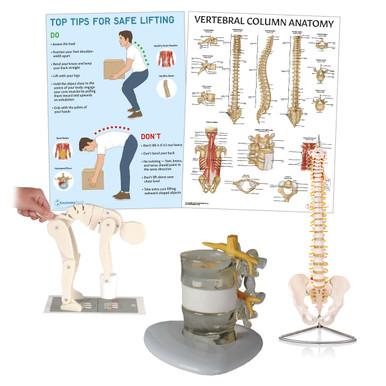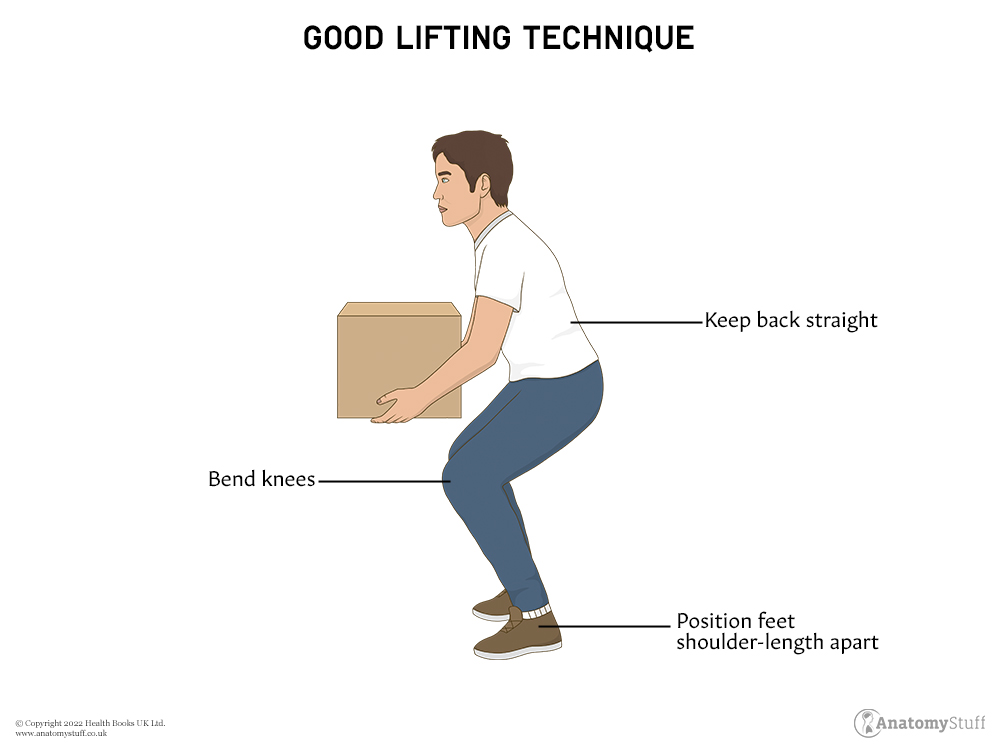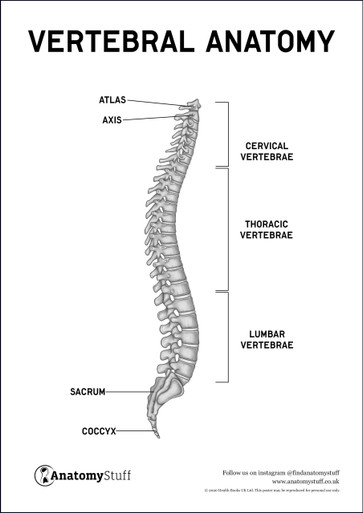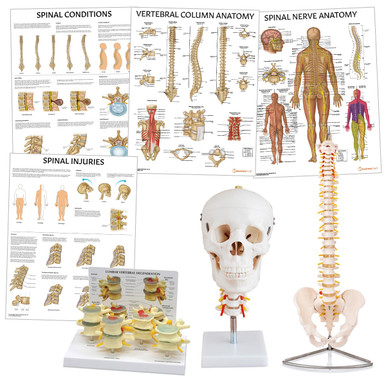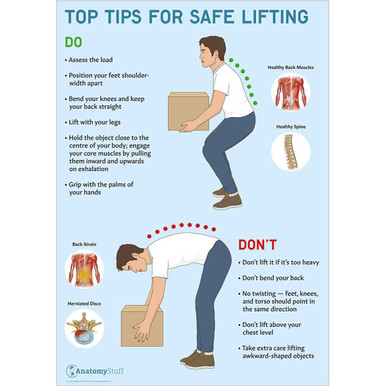Lower Back Pain – Causes and Treatments
Lower back pain is one of the worst pains you can experience and can make life miserable for those affected. It can reduce mobility, cause severe pain, and, if chronic, even lead to depression. Take a look at the anatomy of lower back pain to find out more.
Up to 60% of all adults in the UK will likely experience some form of back pain in their life, and 80% of those people will experience lower back pain.
While lower back pain will sometimes improve by itself or with the help of pain relief, additional treatment may be required in other, more serious cases.
To treat and manage lower back pain, we must first understand it. For that reason, here’s a more detailed look at lower back pain, including causes and treatments.
For more information – take a look at our educational materials, charts, and products to help you better understand how you can manage your condition successfully.
Causes of Lower Back Pain
We’ll begin by looking at some of the most common causes of lower back pain.
Muscle strain
Muscle strain is one of the most common causes of lower back pain in the UK.
Muscle strains can occur for a whole variety of different reasons. They may be overused while exercising, they may be strained due to overuse, you may have picked up an injury, or the muscle may simply have been overworked and overused.
Obesity
The obesity epidemic plaguing the UK is showing no signs of letting up. Not only does obesity dramatically increase your risk of suffering serious and potentially fatal health issues such as heart attacks and strokes, and it can lead to chronic lower back pain.
The heavier you are, the more weight your lower back is forced to support, especially when sitting down. Putting all this strain and pressure on your lower back for hours on end while sitting can result in muscle strains and chronic lower back pain, which can be debilitating in many instances.
Osteoarthritis
Out of the many forms of arthritis, osteoarthritis is the most common.
The condition occurs when cartilage located within the joints begins to deteriorate and break down. How does this cause lower back pain? Because joints in the spine also contain cartilage.
When this occurs, chronic lower back pain can set in and can be incredibly painful.
Signs of osteoarthritis include inflammation, stiffness, limited mobility, and pain and discomfort.
Osteoporosis
Osteoporosis is a condition causing calcium to leech from the bones and causes bone mineral density to reduce, resulting in weak and brittle bones.
This can cause bones in the spine and the back to become brittle and even to collapse, resulting in severe lower back pain.
Spinal stenosis
Spinal stenosis is a condition characterised by a narrowing of the spinal canal.
When this occurs, it can cause numbness, a burning sensation in the lower back and butt, and lower back pain, which can be moderate or severe.
Trauma/injury
Another prevalent cause of lower back pain is trauma or injury.
Whether it’s a slip, fall, bump, or any other accident, if the injury has affected the lower back and caused any damage, no matter how minor you think it is, it could cause lower back pain.
Sciatica
Sciatica and lower back pain often go hand in hand with one another because they’re so commonly associated with each other.
Sciatica is a shooting pain that travels down the sciatic nerve, running from the lower back, down the buttocks, and all the way to the base of each leg. It causes pain, numbness, and inflammation in the affected areas.
Sciatica may be triggered by bone spurs, poor posture, spinal stenosis, or simply just randomly. It often lingers for a minimum of 2 weeks and may ease in terms of severity or clear up entirely by itself.
Poor posture
Finally, poor posture is another widespread cause of lower back pain.
Poor posture, such as slouching when sitting at a desk or hunching your shoulders too far forwards or backwards, can put a lot of pressure and strain on different parts of the back rather than helping to spread your weight evenly.
Safe Lifting Tips for Lower Back Pain
Whether you’re looking to manage lower back pain, or prevent it in the future, how you lift things up off the ground can be very important.
Here are some safe lifting tips to help reduce and prevent lower back pain:
• Never lift more weight than you are able to manage
• Never round or arch your back while lifting
• Keep the item you are lifting as close to your body as possible
• Never twist or turn your body or back when lifting
• Generate power from your legs and lift with them and your knees
• Keep your back upright and your head up while you lift
Free PDF Downloads
View AllLower Back Pain Treatments
If you are unfortunate enough to suffer from lower back pain, you will want to get some much-needed relief as soon as possible.
Here’s a look at several effective lower back pain treatments and remedies.
Hot and cold therapy
Hot and cold therapy is getting a lot of attention as of late, thanks partly because a lot more pro athletes are using it to recover following a gruelling workout.
For lower back pain, hot and cold therapy is ideal. Begin by applying an ice pack to the painful area, leaving it for around 15 minutes. The cold will reduce blood flow and constrict capillaries, which in turn eases swelling.
Next, apply a warm compress, which will loosen up stiff and tense muscles and boost circulation, allowing more oxygen to the affected area to assist with healing.
Light stretches
Light stretches are beneficial for people dealing with lower back pain.
Gentle stretches will help straighten the spine and loosen stiff and tense muscle tissue in your lower back.
Gentle exercise
Contrary to popular belief, bed rest is one of the worst things for lower back pain, as it can really exasperate the pain and make it worse.
Experts recommend gentle, low-impact exercises such as walking, swimming, or a very gentle yoga session.
Anti-inflammatory painkillers
Anti-inflammatory drugs may not cure back pain, but they can mask and manage it.
A muscle strain or strained ligament often causes lower back pain. This causes the affected area to become inflamed and swollen, causing more pain. Anti-inflammatory medicines help ease painful swelling and inflammation.
Physio therapy
Physio therapy may be required in more extreme cases of lower back pain.
With physio therapy, a trained and qualified physio therapist will examine your back and teach you stretches and exercises you can do to correct possible imbalances which could be causing your pain or making it worse.
In more extreme and advanced cases of lower back pain and discomfort, a physio therapist may also carry out treatments in the form of massage, ultrasound, electrical stimulation, shockwave therapy, or active release therapy.
Cognitive Behavioural Therapy (CBT)
Cognitive Behavioural Therapy is also a possibility in terms of lower back pain treatments.
With CBT, the idea here is to alter how you perceive pain, think about pain, and how to manage pain. Rather than focusing on the physical side of things, CBT is instead all about focusing on the psychological side of things.
There you have it, lots to try to relieve your lower back pain, but remember to always consult with your healthcare professional before you try exercising or any other treatments.
If you suffer with lower pack pain take a look at our guide to lower back pain.
Related products
View All